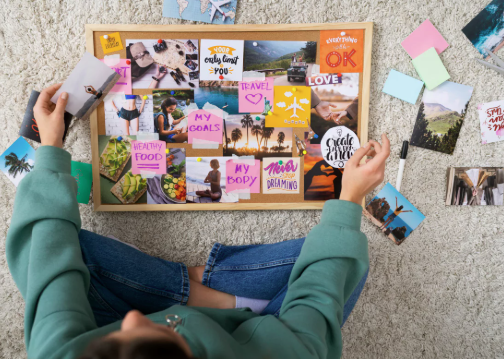A vision board is a creative and powerful tool that helps students focus on their academic goals through visual inspiration and positive reinforcement. By organizing images, words, and symbols that reflect personal aspirations, students can stay motivated and committed to their educational journey. A well-designed vision board encourages clarity, consistency, and long-term planning, which are essential for academic success.
To begin, students should reflect on what they want to achieve in school. These goals can range from earning higher grades and improving study habits to getting accepted into a dream college or exploring new academic interests. Writing down these intentions provides clarity and a starting point for building the vision board. It also allows students to break larger goals into smaller, manageable objectives, such as completing homework on time, participating more in class, or reading more regularly.
Once goals are identified, students can gather materials for their board. This may include poster paper, scissors, glue, magazines, printed images, markers, and stickers. Digital vision boards are also a popular option, using tools like Canva, Google Slides, or PowerPoint to create a collage online. Choosing between physical and digital formats depends on personal preference, but both approaches can be equally effective in reinforcing goals.
Students should then select visuals and quotes that represent their academic goals. For example, an image of a university logo can symbolize a college aspiration, while a picture of a stack of books can represent improved study habits. Photos of organized desks, report cards with high grades, and inspirational figures in education can all serve as motivational symbols. Positive affirmations like “I am focused,” “I can achieve anything,” or “Learning is growth” can reinforce a growth mindset.
Assembling the board is a personal process. Students can organize their images by themes such as short-term vs. long-term goals, subjects they want to improve in, or skills they want to develop. They may even create different sections of the board for different areas of life, such as academics, extracurriculars, personal development, and college readiness. The layout doesn’t have to be perfect—what matters most is that it resonates with the student’s vision and inspires action.
Once completed, the vision board should be placed in a space where it can be seen daily—such as a bedroom wall, locker, or study area. Regularly viewing the board helps students stay focused, visualize success, and remain accountable to their goals. Revisiting the vision board weekly or monthly to assess progress and make adjustments ensures it remains a dynamic and relevant tool.
Educators and parents can support students by encouraging vision board projects in classrooms or at home. Teachers might incorporate vision board activities at the beginning of a semester to help students set clear academic goals. Parents can help by discussing their children’s aspirations and offering encouragement as they work toward them. These activities promote self-reflection, goal setting, and personal motivation, all of which are important for academic success.
Building a vision board is a simple yet effective strategy for students to take ownership of their learning. It turns abstract goals into concrete images and inspires consistent effort, reminding students that with vision and determination, academic success is within reach. Over time, students who use vision boards often report increased motivation, improved focus, and greater satisfaction in their educational journey.
In conclusion, vision boards serve as a bridge between dreams and actions. By making goals visible and personal, they encourage students to stay the course, celebrate small victories, and continuously push toward excellence. Whether in a classroom setting or as a personal project, creating a vision board is a meaningful step toward academic growth and lifelong success.














